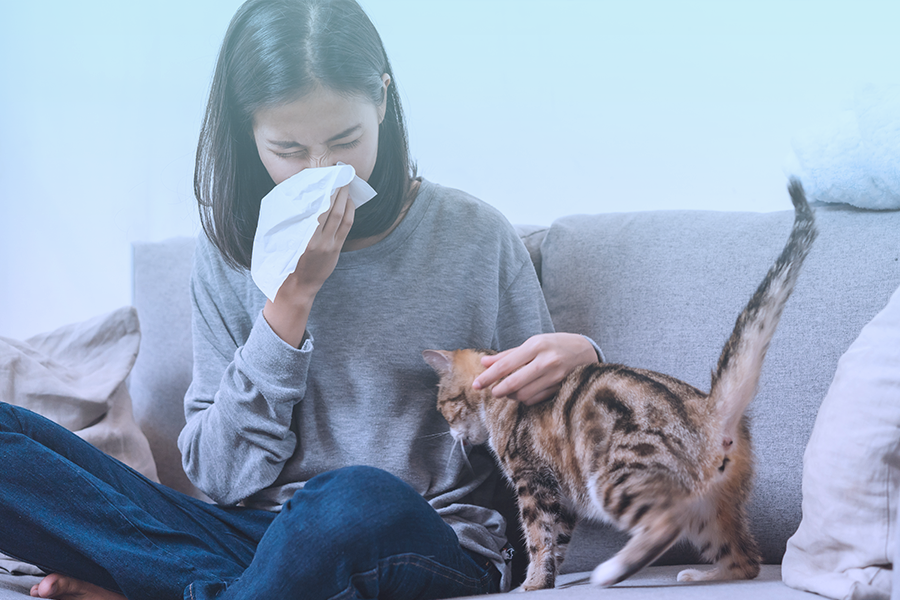
Defeat Texas Allergy Season Once and For All
If you’re an allergy sufferer, The Lone Star State can be unforgiving. As Texas allergy season takes hold, you may find yourself frantic for quick relief. Tired of symptoms? Learn how to manage your seasonal allergies effectively and consistently as soon as you can.
The large southern state of Texas is well known for its gorgeous landscapes, teeming cities, charming culture, and one-of-a-kind hospitality. But there’s a catch. One of the worst states for seasonal allergies, Texas can hit you hard where it hurts. Stuffy nose, sneezing and coughing, looking haggard and feeling yucky - you know the drill.
From limiting exposure to using common medicines and even allergy drop immunotherapy, there are various ways to address your TX allergies.
Let’s dive into all the details of Texas allergy season so you can start your journey to better, less-congested living immediately.
Texas Allergy Season: Understanding the Basics
While the beauty and diversity of Texas’ nature are undeniable, they can also be quite the headache! Like many states, Texas has an allergy season that varies month by month. From Mulberry tree pollen in the winter and spring to Oak trees in the spring and summer, and tumbleweeds in the summer and fall, Texas allergy season has many ways to trigger your symptoms.
Whether tree, grass, or weed pollination, the sources of Texas seasonal allergies are all around you. Unfortunately, it doesn’t stop with just pollen.
Other Sources of Texas Seasonal Allergies
We commonly think of pollen as the main issue in Texas allergy season, but as it turns out, that’s just a part of the problem! We should never forget the role of mold, which loves to accumulate indoors year-round. Because mold is often highly resilient, you may even find growth in the driest conditions, such as the High Plains.
You should also be wary of dust and dander which often spread long distances thanks to those robust Texas winds. From the great outdoors to confined indoor spaces, dust and dander are a year-round problem, regardless of weather patterns.
When Does Allergy Season in Texas Start and End?
The term Texas allergy season is a bit of a misnomer. After all, there are four seasons in the year, and depending upon your sensitivities and location, you may experience allergies across all four of them.
Let’s do a quick breakdown of the most problematic symptoms you may experience throughout each Texas allergy season.
Winter Allergy Season in Texas
Known colloquially as “mountain cedar season,” the Texas winter allergy season typically begins in mid-December and concludes in mid-February. Locals call this “cedar fever”. As the name indicates, this is the period when male cedar trees pollinate, releasing untold billions of pollen grains into the air and wind. In fact, many people actually report seeing a yellowish cloud of pollen. This sudden release can rapidly bring on flu-like symptoms to those who are susceptible.
If you experience ‘cedar fever,’ you may have a slightly raised temperature with congestion, sore throat, watery eyes, and other common allergy symptoms.
Spring Allergy Season in Texas
Welcome to tree pollen allergy season! Typically running from March through May, this Texas allergy season ushers in the highest tree pollen counts of the year. If you’re somebody who is out and about, it’s a good idea to listen to local forecasts about these counts. You can expect trees such as Cedars, Pecans, Cottonwoods, and Maples (among many others) to trigger symptoms, especially in South Central Texas.
Texas Allergy Season in the Summer
With ocean-blue skies and long, scalding stretches, Texas summers are often a haven for pesky allergens. The third hottest state on average behind Florida and Louisiana, Texas unleashes its grass pollen from June through mid-September. Fortunately, the extent of these pollen counts varies greatly by location. If you’re lucky, you’ll only have to endure several weeks of high grass-pollen counts before things settle.
Seasonal Fall Allergies in Texas
Ready for relief? The good news is, autumn allergies in Texas are relatively mild compared to the other months. With reduced pollen counts during the Texas fall season, you can finally breathe a little easier. But don’t let your guard down just yet! Lasting from the end of September to the middle of November, the fall Texas allergy season is still ripe for ragweed. In Central Texas especially, ragweed loves to linger. With approximately 25% of the country allergic to ragweed, Texas’ fall allergy season can get a little… congested.
Remember, the season is only ‘mild’ if it’s mild to you! Know your unique sensitivities and lifestyle to reduce your exposure and treat your particular symptoms.
Should You Be Concerned About Texas Allergy Season?
As always, your reaction to Texas allergens will vary depending on numerous factors such as your region, your immune system, weather patterns, and other climate-related variables. While you can take many preventative and therapeutic steps to reduce symptoms, you should be aware: certain parts of Texas are generally not considered allergy-friendly.
According to the Asthma and Allergy Foundation of America, Texas’ two main cities, Dallas and Houston, rank in the top 20 worst places to live for allergy sufferers. In fact, Dallas ranks as number two in the entire country in 2023!
How Does The Climate Impact Texas Allergy Season?
One of the primary reasons for seasonal allergies in Texas is the state’s diverse climate. Notably warm and humid during the spring, the Texas climate is perfect for mold to grow and fester. Meanwhile, the countless tree species are ripe to release their pollen for many miles, affecting residents far from the epicenter.
The summer season is no different, with heat and humidity again exacerbating allergens, this time from grass pollen. Once more, mold spores flourish as the moisture in certain Texas regions fuels their spread.
But Don’t Forget Fall and Winter Allergies!
As temperatures decrease in the fall and winter, ragweed and sagebrush take hold, triggering symptoms in millions. People also congregate indoors as fall leads to winter, contributing to dander and dust mite issues. Dust mites are especially problematic, as they love to burrow into your carpets, bedding, and upholstery. Combined with moisture-loving mold in basements and bathrooms, and dander from your beloved pets, and you could be looking at some serious symptoms come Texas winter allergy season.
Main Allergens In Texas’ Allergy Seasons
Seasonal allergy patterns and symptoms are changing across the world. As the impacts of shifting flora, climates, and industrial practices are realized, more and more people may notice symptoms. If you’re struggling with seasonal allergies in Texas for the first time, or find your reactions worsening, don’t get discouraged.
At Quello, our targeted sublingual drops treat allergies for every season. When Texas allergy season has you feeling under the weather, consider the following causes:
- White Sagebrush
- Perennial Ragweed
- Russian Thistle
- Lamb’s Quarters
- Bahia Grass
- Bermuda Grass
- Orchard Grass
- Timothy Grass
- Birch Tree
- Oak Tree
- Pine Tree
- Pecan Tree
- Juniper Tree
Remember, these are just trees, grasses, and weeds that trigger pollen reactions. You may also experience occasional or ongoing symptoms from other allergens and irritants. As previously mentioned, dander, mold, and dust mites are particularly problematic during Texas allergy season.
Black mold especially can cause respiratory issues. Together, these various allergens can trigger a spectrum of symptoms, even leading to severe allergy fatigue.
Does Texas Allergy Season Vary By Region?
Absolutely. Because Texas is such a large state with unique weather patterns and climates, people in one region may experience Texas allergy season quite differently than residents somewhere else.
Let’s explore some of these differences and what to expect:
South Texas Allergy Season
Known for the cities of San Antonio, Houston, and Corpus Christi, southern Texas is arguably the best region in Texas for allergy sufferers. With a reduced pollen count relative to northern and central regions, the southern lands mostly experience pollen from trees. Bermuda grass is the only irritant for people with grass allergies, while Ash and Mulberry are the main culprits for tree allergies.
The main issue to worry about in the south is weed allergens. White Sagebrush and the interestingly named Chinese Mustard are two primary sources of symptoms, but fortunately disappear in the winter.
North Texas Allergy Season
The humid, subtropical climate of Northern Texas makes it a perfect location for many allergens year-round. Compared to the muggy summers, the winter temps can get pretty low with ample wind. If you live in or near major cities like Dallas or Fort Worth, you can expect allergens no matter the Texas season.
The ragweed, Spiny Amaranth, triggers symptoms all months of the year, as well as grasses like Bermuda. During the spring, pollen from Pecan Trees, Oak Trees, and certain Cedar Trees bring on symptoms, before various ragweed species start propagating from summer to fall.
If you’re worried about the winter allergy season, Juniper and Mulberry trees are a main source of allergy symptoms. Overall, the North Texas allergy season is basically a month-to-month affair, depending on your sensitivities and exposure.
Central Texas Allergy Season
If you live around Austin or Waco, you can expect to experience conditions very similar to those to the north. Central Texas’ fall allergy season is typically dominated by Privet plants, while Orchard, Bermuda, and Winter Bent grasses become noticeable toward the end of spring into summer.
Compared to the northern Texas allergy season, Central Texas has a milder winter. During these colder months, the pollen counts drop as indoor allergens become a greater concern. However, that doesn’t mean Central Texas is in the clear. Ragweed is especially problematic in Central Texas, with its pollen counts higher in the fall, summer, and spring than in the northern region.
Want to Avoid Symptoms During Texas Allergy Season?
Of course you do, but it’s not always as easy as we think. While locking ourselves indoors during the warmer months, and preventing growth and infestation during the colder months, may sound feasible, it’s rarely a cure-all. Sometimes, the only way to truly ‘avoid’ Texas allergy season symptoms is to treat them effectively.
Nonetheless, here are some steps you can take to decrease your allergen exposure:
- Rather than keeping your windows open and allowing allergens to flow in, try to use your AC whenever possible. It might be tempting to cut off the air conditioning, especially given the price of utilities these days, but think of the benefits. Your health and well-being will thank you!
- Monitor local forecasts and weather reports for pollen counts. During the peak of Texas allergy season in the spring and fall, try to stay indoors or limit outdoor activity. At the very least, reduce your exertion level. High pollen counts can spell disaster for individuals with asthma.
- Regular home and vehicle maintenance are key to ensuring a clean, safe, allergen-free environment. Although you can’t possibly remove all irritants, regular cleaning and sterilizing are great ways to address many common allergens. Pollen, animal dander, dust, and mold can all be addressed with regular maintenance and upkeep.
- Consider wearing a mask when engaging in activities in areas with allergens or irritants. Whether you’re using heavy-duty household cleaners, or entering environments filled with dust and ragweed, a filtering device may be ideal for reducing allergen inhalation.
- Practice proper hygiene. This one is obvious, but during Texas allergy season, consistent hygiene is a must. If you’re frequently exposed to allergens, it’s a good idea to shower or at least wash your hands and face and change your clothes.
- Get tested! At-home allergy tests make testing for allergies easy and convenient. It only takes a couple minutes and then you can send your sample off to a laboratory for analysis. From there, you can get tailored treatments just for you. At Quello, our fully personalized allergy drops can help you overcome your sensitivities quickly and hassle-free.
The science of overcoming allergies is changing every day, so if you’re looking for new, improved ways to treat your allergies, you may just be in luck…
Treating Texas Allergy Season Effectively
Many patients are now using Proprietary Sublingual Immunotherapy to treat their allergies. These allergy drops are delivered daily under the tongue and can be done in just seconds from the comfort of your home.
All you have to do is use an at-home test kit, provide a blood sample, and send it to our lab for analysis. In a short time, we can provide a drop formulation tailored exactly to your unique sensitivities.
**Note: Sublingual immunotherapy has been shown by some research to be effective. Not all patients enjoy success with allergy drops, so be sure to consult your healthcare provider for the appropriate treatments for your needs.

FAQ
What Is Texas Allergy Season?
With 60 million people suffering from seasonal allergies in the U.S., Texas is surely a contributor. Although sensitivities to allergens differ from person to person, the peak months of Texas allergy season are typically December, January, May, and September. This is when pollen counts are at their highest, but other allergens - such as dander, dust, and mold - can set off allergies year-round.
Am I Susceptible to Texas Allergy Season?
You will likely know if you have sensitivities to seasonal allergies in Texas. Symptoms can vary widely but include itchy and watery eyes, scratchy throat, runny nose, coughing, headache, and fatigue. The best way to know if your issues are caused by allergens is to take an at-home allergy test.
Why Should I Take An At-Home Allergy Test?
At Quello, our at-home allergy test is completely FREE. The test kit comes with all the instructions and tools you need. Once you’ve provided a blood sample on the blood drop card, fill out the submission form, and return the prepaid envelope to the labeled address. Our experts will get hard to work on determining the allergens causing your symptoms and creating your own, personalized allergy drops!
Can Allergy Drops Help Me?
Not long ago, “immunotherapy” only included allergy shots. These injections require that you visit a doctor weekly, costing you time, money, and quite a bit of stress. While the injections do demonstrate efficacy, they also cause pain and can trigger the very symptoms you’re trying to eliminate!
With Quello, you enjoy simple, convenient, at-home allergy drops that go right under your tongue. If you have any questions or concerns, you can receive online support or schedule a virtual consultation whenever you want.
Reach out to our allergy specialists today.

Overcome your allergies at home with our doctor-led therapy.
Get started with our free allergy test kitGet Started with no test needed.
Overcome your allergies at home with our doctor-led therapy.
Get started with our free allergy test kitGet Started with no test needed.



